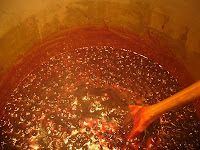 In the Hudson Valley right now black currants are ripe and ready. Some strawberries are, too, and this week we should have blueberries (but our early June cherry crop didn't come this year due to lots of rain and cloudy days). So I went to a local pick-your-own farm and harvested 5 pounds of currants in about an hour. After the first 15 minutes of picking, I remembered that it's hard and tedious work. Each currant bush had dozens of branches with hundreds of berries on them. Not all of them are ripe at the same time, so you have to pick your way through. And since I was planning on making jam right away, I painstakingly made sure there was nothing in that bucket but berries.
In the Hudson Valley right now black currants are ripe and ready. Some strawberries are, too, and this week we should have blueberries (but our early June cherry crop didn't come this year due to lots of rain and cloudy days). So I went to a local pick-your-own farm and harvested 5 pounds of currants in about an hour. After the first 15 minutes of picking, I remembered that it's hard and tedious work. Each currant bush had dozens of branches with hundreds of berries on them. Not all of them are ripe at the same time, so you have to pick your way through. And since I was planning on making jam right away, I painstakingly made sure there was nothing in that bucket but berries.
We preserved a lot of dulces (jams) and fruit down in Argentina, so I just followed the same method up here:
 (1) Wash and sterilize your jars. (Wash jars with warm soapy water, then rinse them in water with a bit of bleach to sterilize them. Then rinse again in clean water. Wash tops with warm soapy water and then sterilize in boiling water. Let jars and tops air dry - don't dry with a towel, etc.)
(1) Wash and sterilize your jars. (Wash jars with warm soapy water, then rinse them in water with a bit of bleach to sterilize them. Then rinse again in clean water. Wash tops with warm soapy water and then sterilize in boiling water. Let jars and tops air dry - don't dry with a towel, etc.)(2) Use a large pot - big enough so that the fruit and sugar only fill it halfway (the jam rises as you cook it). Add your fruit and sugar in a 5:4 ratio. Since I had 5 pounds of black currants, I added 4 pounds of sugar. (This ratio preserves the jam sufficiently to store jars of it at room temperature for four years.)
 (3) Cook the fruit and sugar over high heat, boiling and stirring constantly. You can add a bit of butter to prevent foaming. Cook time can take anywhere from 30 minutes to an hour, depending on the amount you're cooking and the type of fruit. (Black currants are naturally high in pectin, so they take a shorter amount of time. Strawberries, on the other hand, are low in pectin so take longer to reach the right consistency.)
(3) Cook the fruit and sugar over high heat, boiling and stirring constantly. You can add a bit of butter to prevent foaming. Cook time can take anywhere from 30 minutes to an hour, depending on the amount you're cooking and the type of fruit. (Black currants are naturally high in pectin, so they take a shorter amount of time. Strawberries, on the other hand, are low in pectin so take longer to reach the right consistency.)(4) Test for the right consistency by spooning a small amount on a cold, clean plate. Once it cools, tip the plate to see if it runs: when it runs ever so slightly, cook for 1-2 minutes more.
(5) Pour the hot jam directly into your sterilized jars and close immediately. Be sure to use gloves and keep the jar in a metal pot while pouring in case it shatters.


No comments:
Post a Comment